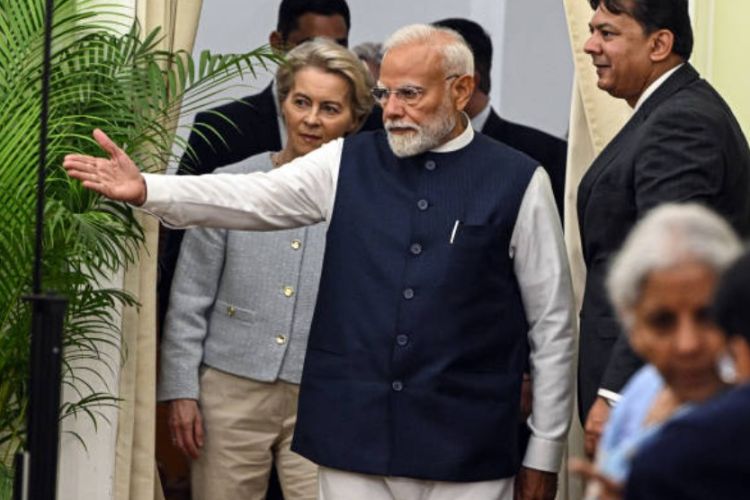
India-EU trade talks: The global trade order is in flux, and 2025 has already delivered more than a few surprises. Nations that spent the past decade throwing up tariff walls are now, in varying degrees, edging back toward the negotiating table. India epitomises this shift. Long accused of protectionism, New Delhi has lately signalled a willingness to reopen talks—not least with the European Union, with whom it remains embroiled in a high-stakes dispute at the World Trade Organisation.
At the heart of the stand-off is India’s decision, first taken in 2014, to levy import duties on a wide range of information- and communication-technology (ICT) products—mobile phones, components, telephone handsets and the like. Brussels argued the move breached the WTO’s Information Technology Agreement, which binds signatories to zero tariffs on such goods. In April 2023 the WTO’s dispute panel agreed, ordering India to roll back the duties. New Delhi lodged an appeal—but with the WTO’s Appellate Body still paralysed, that appeal now sits in what trade lawyers wryly call the “void”.
READ | India’s booming aviation industry masks deep structural problems
Rather than wait indefinitely, the EU has launched its own public consultation under the bloc’s Enforcement Regulation, a mechanism that paves the way for retaliatory tariffs. Simultaneously, officials on both sides are meeting quietly to craft a settlement that would avert escalation. For Brussels, the calculus is clear: with the multilateral system gridlocked, a bilateral bargain may be the only way to protect EU exporters without igniting a wider tariff war.
More than one front
Europe is not the only complainant. Japan and Taiwan have filed near-identical cases, accusing India of flouting the same WTO rules. The pattern underscores a broader tension: Prime Minister Narendra Modi’s government wants to nurture domestic manufacturing through targeted tariffs and subsidies, yet it also craves deeper integration into global value chains. Reconciling those objectives has never been easy, and each new dispute chips away at New Delhi’s hard-won reputation as a predictable trade partner.
What makes the current moment notable is the EU’s restraint. Washington’s instinct under President Donald Trump has been to reach for tariffs at the first sign of friction. Brussels, by contrast, still prefers quiet diplomacy. EU officials say they recognise India’s strategic importance—both as a hedge against Chinese supply-chain dominance and as a vast consumer market. Punitive duties, they argue, are a last resort. By signalling a willingness to talk, the EU hopes to coax India toward compromise while keeping the stick of counter-measures in plain sight.
Across the Channel, a harder line
That pragmatism does not extend to London. Parallel negotiations between India and the United Kingdom have stalled largely over the UK’s forthcoming Carbon Border Adjustment Mechanism (CBAM). From 2027, the levy will slap a carbon price on imports of iron, steel, aluminium, cement and ceramics—products in which India is a major exporter. British negotiators say the climate measure is non-negotiable; their Indian counterparts see it as thinly veiled protectionism. Until someone blinks, the much-hyped UK-India free-trade agreement will remain on ice.
All of this matters enormously to India’s $250-billion IT and business-process-management industry, which still earns roughly 60 per cent of its revenue in the United States, according to NASSCOM. Diversifying into Europe, Japan and Southeast Asia is strategically sensible, but EU data-protection rules and competition from Eastern Europe pose real hurdles. A prolonged tariff quarrel over ICT goods would only complicate that pivot, just as US-China tensions are redrawing technology supply chains.
India-EU trade: A window that shouldn’t close
For now, both New Delhi and Brussels understand the costs of letting the dispute fester. India’s tariffs have become a symbol of its broader industrial policy, yet the country also wants the EU’s capital and technology. Europe, meanwhile, needs reliable new markets as Russia remains off-limits and China grows politically risky. A narrow settlement—one that lowers India’s ICT duties in exchange for phased implementation and perhaps some manufacturing incentives—would serve both sides.
Ultimately, the episode is a reminder that in an era of fraying multilateralism, bilateral statecraft is back in vogue. Whether over ICT tariffs or carbon taxes, the real test for India and its partners is not who can shout loudest at the WTO but who can craft pragmatic deals that keep trade flowing while accommodating domestic political imperatives. Anything less risks leaving both sides poorer—and ceding the stage to those who prefer confrontation to compromise.
